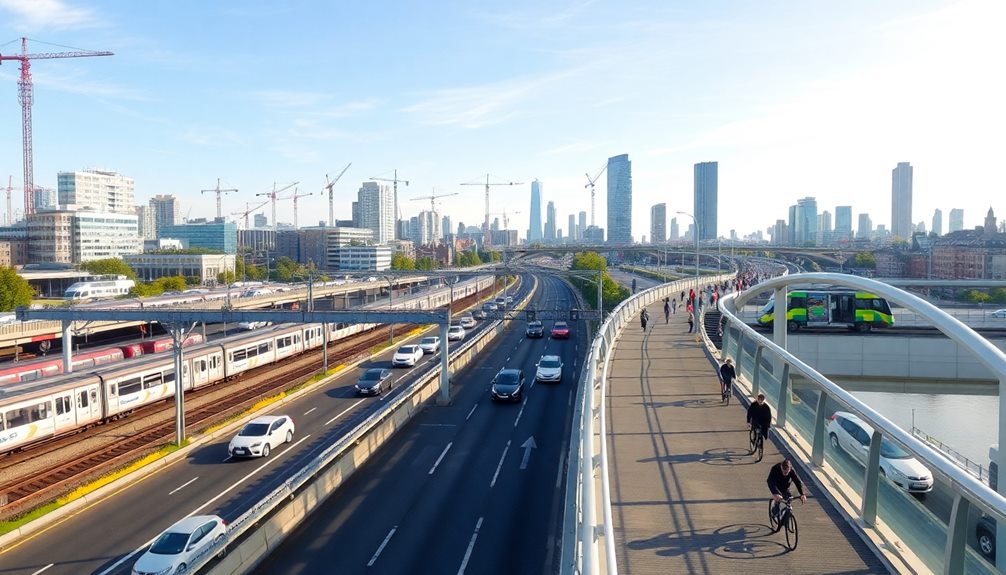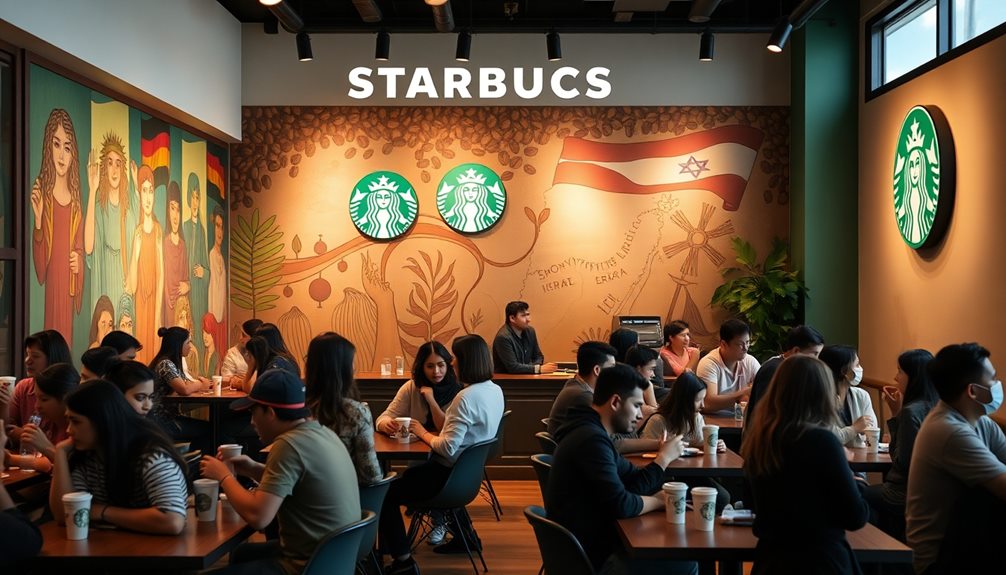The U.S. government's historic investment of $108 billion in public transportation is transforming infrastructure and accessibility. Key programs, like the Low or No Emissions Bus Discretionary Program and the All Stations Accessibility Program, focus on sustainability and inclusivity. You'll find multiple grant opportunities supporting rural transit, COVID-19 recovery, and electric vehicle infrastructure. Programs enhancing mobility for seniors and individuals with disabilities also play a crucial role in improving access. This funding aims to guarantee communities thrive while maintaining efficient transportation networks. Keep exploring to discover how these initiatives impact local infrastructure and your community.
Key Takeaways
- The Bipartisan Infrastructure Law allocates $108 billion for federal public transportation programs from FY 2022-2026, marking a historic investment.
- The Low or No Emissions Bus Discretionary Program funds innovative technologies to promote sustainable public transportation.
- The All Stations Accessibility Program enhances transit station accessibility for individuals with disabilities, ensuring equitable access.
- Formula Grants for Rural Areas (Section 5311) support public transit in rural communities, improving mobility options.
- The American Rescue Plan Act provides $30.5 billion for public transportation recovery, addressing challenges caused by the COVID-19 pandemic.
Overview of Transport Funding
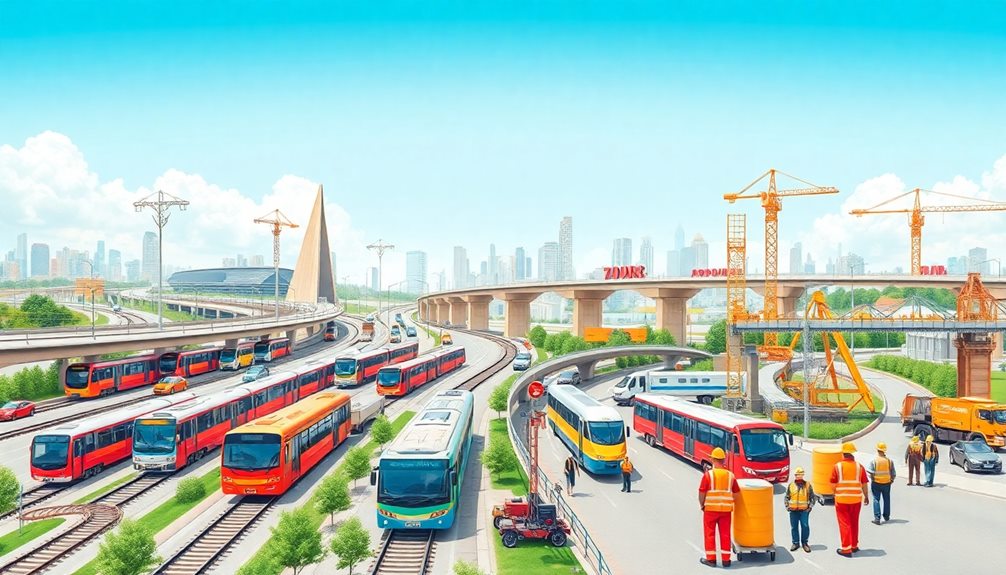
When you look at transport funding, you'll see a historic commitment to improving public transportation across the U.S. The Bipartisan Infrastructure Law allocates up to $108 billion for federal public transportation programs from FY 2022-2026, making it the largest federal investment in this sector in U.S. history. This funding supports a variety of eligible projects aimed at enhancing public transit infrastructure.
Key programs under this law include the Low or No Emissions Bus Discretionary Program, which encourages sustainability in transit operations, and the All Stations Accessibility Program, providing competitive Grants for improving accessibility at public transit stations.
Additionally, the Formula Grants for Rural Areas (Section 5311) focus on public transportation in rural communities, addressing unique transit needs where populations are under 50,000.
The American Rescue Plan Act of 2021 added another layer of financial support, allocating $30.5 billion to assist public transportation systems in overcoming challenges posed by the COVID-19 pandemic.
Discretionary funding programs, like the Bus and Bus Facilities Discretionary Program, further bolster these efforts by providing significant financial support for major infrastructure projects, ensuring a robust future for public transit.
Federal Grant Programs

When you explore federal grant programs, you'll find a range of opportunities designed to enhance public transportation.
These major initiatives, like the Enhanced Mobility of Seniors and Individuals with Disabilities and the Low or No Emissions Bus Discretionary Program, offer discretionary funding that can greatly impact your community.
Plus, they include provisions to support rural areas, ensuring that transportation needs are met everywhere.
Major Grant Programs
Federal grant programs play an essential role in improving public transportation infrastructure across the nation. The Bipartisan Infrastructure Law authorizes up to $108 billion for federal public transportation programs from FY 2022-2026, considerably boosting federal funding for essential infrastructure improvements.
Among the key initiatives is the Grants for Buses and Bus Facilities Program, which supports replacing and acquiring low or no-emission buses, with discretionary grants ranging from $115,000 to $54 million. This effort promotes sustainable transit options and helps meet environmental goals.
Additionally, the Low or No Emissions Bus Discretionary Program funds innovative technologies that enhance public transportation services, contributing to cleaner air and reduced emissions.
The All Stations Accessibility Program offers competitive funding for accessibility improvements at transit stations, ensuring everyone can access transportation regardless of their abilities.
Furthermore, the Enhanced Mobility of Seniors & Individuals with Disabilities program provides formula funding to address the unique transportation needs of elderly and disabled populations, enhancing their mobility options.
Together, these major grant programs facilitate critical transportation projects and support a more inclusive and environmentally friendly public transit system.
Discretionary Funding Opportunities
Building on the foundation laid by major grant programs, discretionary funding opportunities provide targeted financial support for innovative projects that enhance public transportation.
These programs are pivotal in driving forward the goals of sustainable and equitable transit solutions.
Here are some key discretionary funding programs you should know about:
- Bus and Bus Facilities Discretionary Program – Grants from $115,000 to $54 million support major transit projects and sustainability.
- Low or No Emissions Bus Discretionary Program – Focuses on funding projects that promote zero-emission vehicles.
- RAISE Program – Awards from $1.1 million to $25 million for multimodal infrastructure projects that meet federal objectives.
- Enhanced Mobility of Seniors & Individuals with Disabilities – Guarantees equitable access to transit for elderly and disabled individuals.
These discretionary grant programs evaluate projects based on their impact, feasibility, and alignment with the Bipartisan Infrastructure Law, which emphasizes substantial investment in transportation infrastructure.
Rural Area Support
Access to reliable transportation is essential for rural communities, where public transit options can be limited. The Formula Grants for Rural Areas (Section 5311) program helps guarantee public transportation services are available in these regions, providing critical access to mobility for residents in areas with populations under 50,000.
Moreover, the Areas of Persistent Poverty Program offers competitive funding for planning studies that enhance transit access in economically distressed rural areas.
Rural transportation projects can also leverage funding from the Congestion Mitigation and Air Quality Improvement Program (CMAQ), which supports air quality initiatives in rural locations.
The Rural and Tribal Economic Development Program focuses on transportation enhancements that stimulate economic growth, improving access to jobs and essential services.
In addition, the Federal Lands Access Program (FLAP) assists in projects that facilitate access to federal lands, often incorporating the development of EV charging infrastructure in rural areas.
Discretionary Funding Opportunities

Discretionary funding opportunities play an essential role in enhancing transportation infrastructure across the country. They offer vital support for various public transportation projects aimed at improving sustainability and accessibility.
Here are some key programs you should know about:
- Bus and Bus Facilities Discretionary Program: This program funds major projects to replace and rehabilitate buses and bus facilities, ensuring efficient transit options.
- Low or No Emissions Bus Discretionary Program: Focused on promoting low or no-emission transit buses, this initiative enhances sustainability in public transportation.
- RAISE Program: Providing funding for multimodal infrastructure projects, the RAISE program emphasizes zero-emission vehicle infrastructure and EV charging stations.
- Enhanced Mobility of Seniors & Individuals with Disabilities: This program offers formula funding to improve transit services for vulnerable populations, ensuring everyone has access to transportation.
Additionally, the Capital Investment Grants – 5309 program supports significant transit capital investments with competitive funding and multi-year options.
Support for Rural Areas

Support for rural areas is crucial in guaranteeing that all communities have reliable transportation options. The Formula Grants for Rural Areas – 5311 program plays a pivotal role by providing funding specifically for public transportation in communities with populations under 50,000. This funding guarantees access to essential services and job opportunities that many rural residents depend on.
Additionally, the Areas of Persistent Poverty Program supports planning studies aimed at enhancing transit in economically distressed regions, targeting transportation inequities that exist in these areas.
Moreover, Flexible Funding Programs like the CMAQ and the National Highway Performance Program prioritize air quality improvement and the condition of the National Highway System, respectively, which ultimately benefits rural infrastructure.
The Surface Transportation Block Grant Program also offers flexible funding to address various transportation projects tailored to the unique needs of rural areas.
COVID-19 Recovery Initiatives
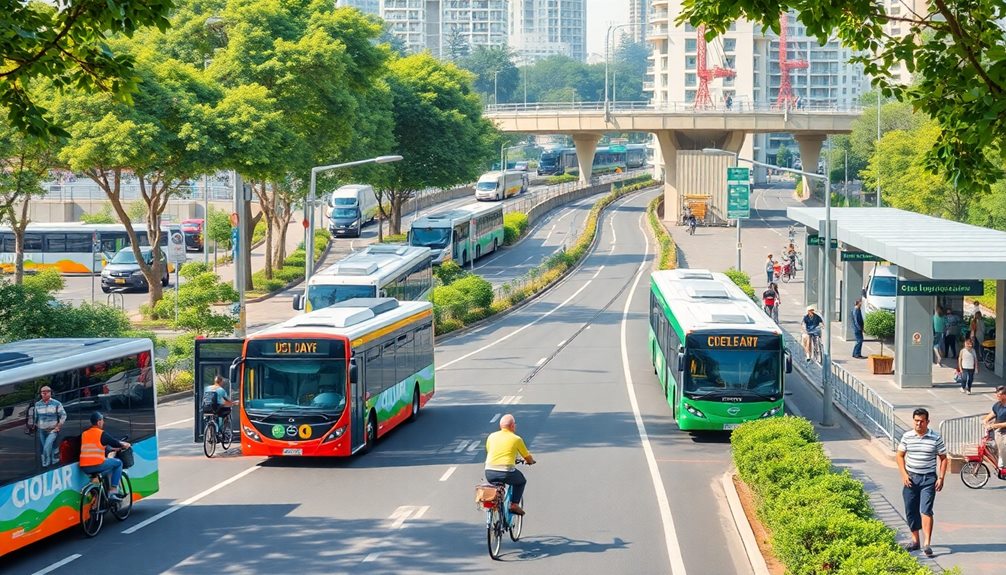
As rural communities work to strengthen their transportation infrastructure, the focus has shifted to the impact of the COVID-19 pandemic on public transit systems. The American Rescue Plan Act of 2021 allocated $30.5 billion specifically for public transportation, providing essential funding to support recovery efforts. This financial boost helps transit agencies maintain operations, restore service levels, and avoid layoffs during these challenging times.
Here are key initiatives aiding recovery:
- Community Project Funding: Introduced in FY22, this directs congressional funding to specific transportation projects.
- Grants from the Federal Transit Administration (FTA): These enhance ferry services and expand public transport options.
- Competitive Funding for Planning Projects: This helps develop strategies for accessible and reliable transportation.
- Support for Transit Agencies: Helps maintain service levels and continue operations amidst financial strains.
These initiatives are vital for ensuring reliable transportation as communities move forward.
Electric Vehicle Infrastructure

With the growing emphasis on sustainability and cleaner transportation options, investing in electric vehicle (EV) infrastructure has become vital for communities nationwide.
The Bipartisan Infrastructure Law allocates $5 billion over five years for the National Electric Vehicle Infrastructure (NEVI) Formula Program, aimed at deploying essential charging infrastructure across the U.S. This initiative guarantees that every state adheres to the EV Charging Minimum Standards Rule, focusing on building DC fast chargers every 50 miles on designated corridors.
Additionally, the Charging and Fueling Infrastructure Discretionary Grant Program offers competitive grants, with at least 50% of funding dedicated to low-income community projects. These grants range from $500,000 to $15 million, supporting diverse transportation projects.
The Clean School Bus Program further complements these efforts by designating $5 billion for clean buses from FY 2022 to FY 2026, providing rebates for zero-emission buses and funding for necessary charging infrastructure.
Key Success Stories
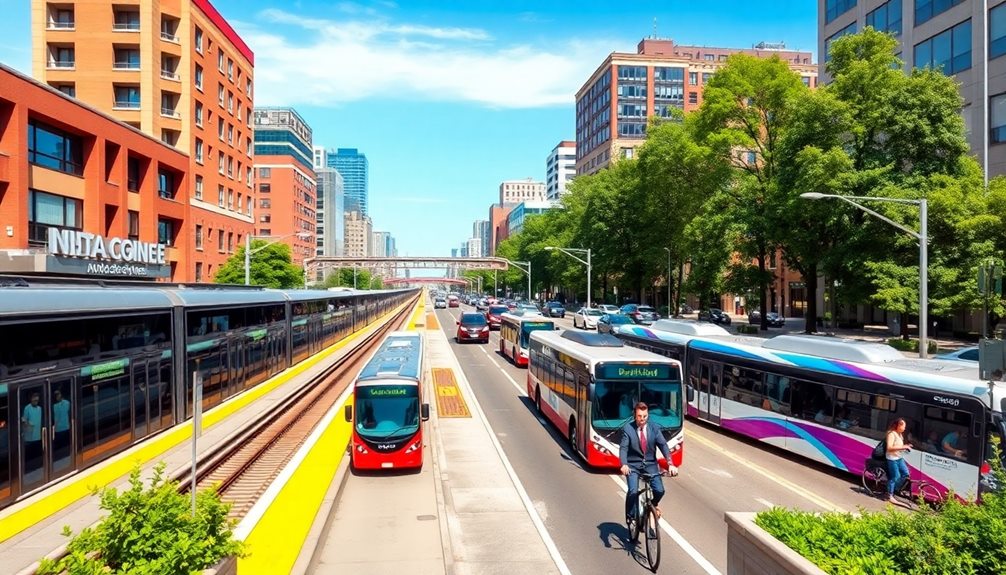
You've likely seen the positive effects of successful infrastructure projects in your community, from upgraded transit stations to new bus lines.
These initiatives not only enhance accessibility but also create a significant community impact by improving mobility for everyone.
Let's explore some of these key success stories that highlight the benefits of effective transport funding.
Successful Infrastructure Projects
Successful infrastructure projects demonstrate the essential role of effective funding programs in transforming communities. These initiatives not only improve transportation services but also enhance quality of life.
Here are four key success stories that showcase the impact of successful programs:
- All Stations Accessibility Program: This project funded accessibility improvements at transit stations, ensuring individuals with disabilities and seniors can navigate urban areas more easily.
- Better Utilizing Investments to Leverage Development (BUILD): Through this program, multimodal transportation projects were completed, markedly increasing connectivity and economic development in underserved regions.
- Enhanced Mobility of Seniors & Individuals with Disabilities: This initiative led to increased transportation options for over 200,000 elderly and disabled individuals, fostering greater independence.
- Low or No Emissions Bus Discretionary Program: With funding for over 1,000 low-emission buses, this program actively reduced greenhouse gas emissions, promoting sustainable public transit solutions.
These successful projects underscore how targeted funding can create transformative improvements in transportation, support community needs, and contribute to a greener future.
Community Impact Highlights
Effective funding programs haven't only propelled successful infrastructure projects but also left a lasting impact on communities across the nation. The Bipartisan Infrastructure Law, allocating up to $108 billion for federal public transportation programs, is a prime example. From FY 2022 to FY 2026, this funding is set to notably enhance transit infrastructure, fostering community mobility.
One standout initiative is the Enhanced Mobility of Seniors & Individuals with Disabilities program, which provides essential funding that improves transportation options for the elderly and disabled. This guarantees they can access crucial services and participate in their communities.
Additionally, the All Stations Accessibility Program supports accessibility improvements at public transit stations, making transportation more inclusive for individuals with disabilities.
Moreover, the Capital Investment Grants – 5309 program has delivered multi-year funding for transit capital investments, leading to improved systems and increased ridership in urban areas.
During the COVID-19 pandemic, the American Rescue Plan Act of 2021 allocated $30.5 billion to public transportation systems, helping maintain services and jobs, thereby ensuring economic stability in communities.
These key success stories highlight how effective funding can transform lives and strengthen communities.
Frequently Asked Questions
What Are Bil Funds?
BIL funds refer to the financial resources allocated under the Bipartisan Infrastructure Law, which you can use to enhance public transportation.
You'll find that up to $108 billion is authorized for federal public transit programs through 2026.
These funds support various initiatives, like purchasing low or zero-emission buses and improving accessibility at transit stations.
Ultimately, these investments aim to modernize transit systems and promote sustainability and better air quality in your community.
How Does the Federal Government Fund Transportation?
The federal government fuels transportation funding through various avenues.
You'll see significant sums from the Bipartisan Infrastructure Law, which invests billions in public transit. Discretionary grants support sustainable projects, while formula grants guarantee rural regions receive necessary resources.
Additionally, the American Rescue Plan provides essential cash for pandemic recovery.
With programs targeting seniors and individuals with disabilities, the government's commitment to extensive transportation solutions shines through, helping everyone connect and commute confidently.
Who Is Eligible for Iija Funding?
You'll find that eligibility for IIJA funding primarily includes state and local governments, transit agencies, and tribal organizations involved in public transportation projects.
If you're part of an organization focused on the transportation needs of seniors or individuals with disabilities, you can access specific funding programs.
Additionally, rural transit agencies and entities engaged in innovative mobility initiatives can also qualify for various grants under the act, supporting diverse transportation solutions.
How Much Money Is in the Bipartisan Infrastructure Law?
Imagine a treasure chest bursting with opportunities; that's the Bipartisan Infrastructure Law for public transportation.
It releases up to $108 billion from FY 2022 to FY 2026, with a guaranteed $91 billion flowing directly to states and transit agencies.
This historic investment aims to transform the way you travel, replacing old buses and enhancing facilities.
You'll witness the evolution of public transit like never before, paving the way for a more connected future.
Conclusion
In the world of transport funding, you've seen how essential federal grants and discretionary opportunities pave the way for infrastructure growth. Remember, "where there's a will, there's a way." By supporting rural areas and embracing initiatives like electric vehicle infrastructure, you're helping create a sustainable future. As recovery from COVID-19 continues, these key programs will guarantee smoother journeys ahead. Stay informed and engaged, and together we can build a stronger, more connected transportation network.

